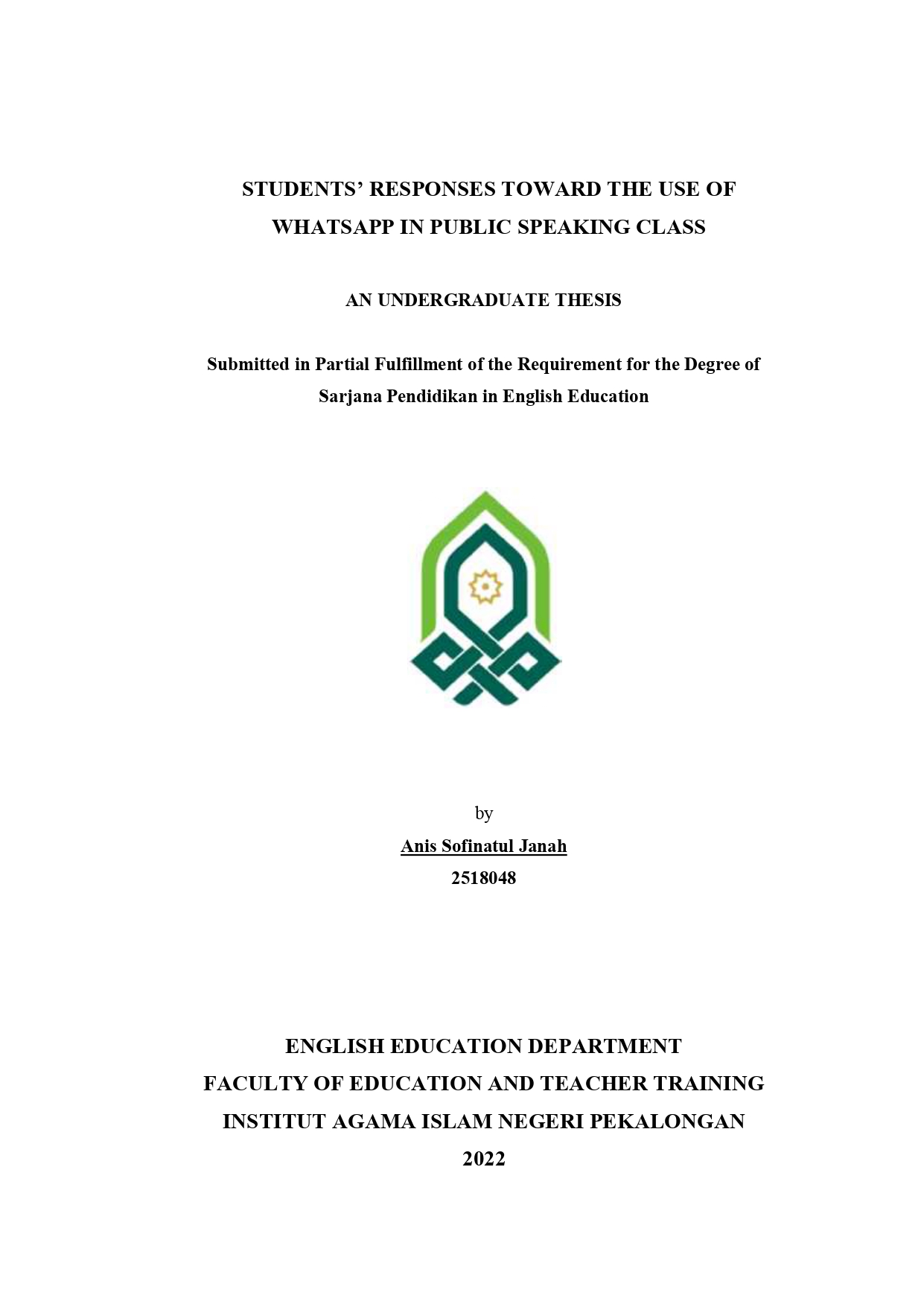
SKRIPSI TADRIS BAHASA INGGRIS
Students' Responses Toward The Use of Whatssapp in Public Speaking Class
This study aims explored how students use and respond to the use of WhatsApp as
a media in public speaking class. This study was qualitative study used narrative
inquiry as the research design. In collecting the data, this research used
interviews. The data analysis techniques used by the researcher was analysis
techniques based on models from Miles and Huberman. The participants of this
research were students of English Department at IAIN Pekalongan. The findings
show that WhatsApp is used to send file document used for presentation, discuss
material and share material through group chats, conduct questions and answers
using the message feature, and describe an object using photo feature as well as
present an object using video feature. Its use in public speaking brings different
responses. Some of them respond it positively, and some of them response it
negatively. However, overall, the use of WhatsApp in public speaking class
actually really helped the learning process, especially at the beginning of the
pandemic some time ago. This research contributes to be references about the use
of WhatsApp application as a learning media in public speaking class.
Keyword: WhatsApp, Learning Media, Public Speaking Class
REFERENCES
Ajid, La Hanisi, et al. (2018). The Use of WhatsApp in Collaborative Learning to
Improve English Teaching and Learning Process. International Journal of
Research Studies in Educational Technology,7(1), 31.
Amalia, Mike. (2020). WhatsApp Goes to Classroom: Using WhatsApp to Foster
Students’ Speaking Skill in Speech. International Conference on
Education,1(3), 153.
Amini, Aulia. (2021). EFL Junior High Schools Teachers’ Experiences in
Adapting to Online Learning Amidst the Covid-19 Pandemic. Thesis.
Faculty of Education and Teacher Training Institute Agama Islam Negeri
Pekalongan.
Anderson, Terry. (2004). Toward a theory of online Learning. Canada: Athabasca
University Press Press.
Anderson, Terry. (2011). The Theory and Practice of Online Learning. Canada:
AU Press.
Arina, Nadiah. & Ikhrom. (2019). The Students’ Self-Confidence in Public
Speaking. ELITE JOURNAL: Journal of English Linguistics, Literature, and
Education,1(1), 5.
Arkorful, Valentina, & Nelly Abaido. (2014). The Role of E-learning, the
Advantages and Disadvantages of its Adoption in Higher Education.
International Journal of Education and Research,2(12), 398-403.
Breakwell, Glynis, M., Sean Hammond, & Chris Fife-Schaw. (2000). Research
Methods in Phychology (ed. ke-2). London: SAGE Publications Ltd.
Clandinin, D. Jean. (2006). Narrative Inquiry: A Methodology for Studying Lived
Experience. Rusia: SAGE.
Daymon, Christine, & Immy Holloway. (2008). Metode-metode Riset Kuantitaif
dalam Public Reation & Marketing Communication. (Terjemahan Cahya
Wiratama). Yogyakarta: Bentang Pustaka.
Hamad, Mona M. (2017). Using WhatsApps to Enhance Student’s Learning of
English Language “Experience to Share”. Journal Articles, 7(4), 74.
Hancock, B. Adrienne. (2010). Public Speaking Attidudes: Does Curriculum
Make a Different?. Jornal of Voice,24(3).
Hasan, Sigit, et al. (2021). Analysis of Learning Speaking Skill Using the
WhatsApp Application in Elementary Schools. Journal of Physics:
Conference Series,1(1), 1. 303.
Jasrial, Dedi. (2018). Utilizing Whatsapp Application for Teaching English
Language: Why and How?. International Seminar and Annual Meeting
BKS-PTN Wilayah Barat,1(1), 152-153.
Mistar, Izyani binti, & Mohamed Amin Embi. (2016). Students’ Perception on the
Use of WhatsApp as a Learning Tool in ESL Classroom. Journal of
Education and Social Sciences,4(2), 98.
Moore, Joi L. Camille Dickson-Deane. & Krista Galyen. (2011). E-learning,
Online learning, and Distance learning environments: Are they the same?.
The Internet and Higher Education,14(2), 130.
Nurazizah, Hega, Lilies Youlia Frihatin. & Bambang Ruby S. (2019). Whatsapp
Voice Note in Speaking Class. Journal of English Education and Teaching
(JEET),3(3), 345-356.
Pratiwi, Yeyen. (2021). Students Perception on the Use of WhatsApp as a Media
in Learning English during Pandemic Era at the Tenth Grade Students of
SMKN 1 Pekat in Academic Year 2020/2021. Thesis, Faculty of Teacher
Training and Education Muhammadiyah, University of Mataram.
Rebolj, A. Biba. (2013). The Case Study as a Type of Qualitative Research.
Journal of Contemporary Educatioanl Studies,1(3), 32.
Sajjad Kabir, Syed Muhammad. (2016). Methods of Data Collection. Bangladesh:
Book Zone Publication.
Salsabila, Dhiana Shilvina, et al. (2021). English Students Perception on the Use
of WhatsApp Group in Speaking Class. Jurnal Pendidikan Edutama,1(1), 1.
Tholibin, M. Sirojut. (2017). Student’s Perceptions on Using Whatsapp to Support
Learning Process at English Department of STAIN Kediri. Thesis, Faculty
of Educational STAIN Kediri.
Trueblood, C. Thomas. (2009). College courses in public speaking. Quarterly
Journal of Speech,1(3), 262.
William, Carrie. (2007). Research Methods. Journal of Business & Economic
Research, 5(3), 65.
Ketersediaan
| 23SK2325052.00 | SK TI 23.052 ANI s | My Library (Lantai 3. Local Content) | Tersedia |
Informasi Detail
- Judul Seri
-
-
- No. Panggil
-
SK TI 23.052 ANI s
- Penerbit
- Pekalongan : Jurusan S-1 Tadris Bahasa Inggris FTIK UIN K.H. Abdurrahman Wahid Pekalongan., 2022
- Deskripsi Fisik
-
xiii, 36 hlm., 30 cm; Bibliografi: 37-38
- Bahasa
-
Inggris
- ISBN/ISSN
-
-
- Klasifikasi
-
371. 35
- Tipe Isi
-
-
- Tipe Media
-
-
- Tipe Pembawa
-
-
- Edisi
-
-
- Subjek
- Info Detail Spesifik
-
-
- Pernyataan Tanggungjawab
-
Anis Sofinatul Janah (2518048)
Versi lain/terkait
Tidak tersedia versi lain
Lampiran Berkas
Komentar
Anda harus login sebelum memberikan komentar
 Karya Umum
Karya Umum  Filsafat
Filsafat  Agama
Agama  Ilmu-ilmu Sosial
Ilmu-ilmu Sosial  Bahasa
Bahasa  Ilmu-ilmu Murni
Ilmu-ilmu Murni  Ilmu-ilmu Terapan
Ilmu-ilmu Terapan  Kesenian, Hiburan, dan Olahraga
Kesenian, Hiburan, dan Olahraga  Kesusastraan
Kesusastraan  Geografi dan Sejarah
Geografi dan Sejarah